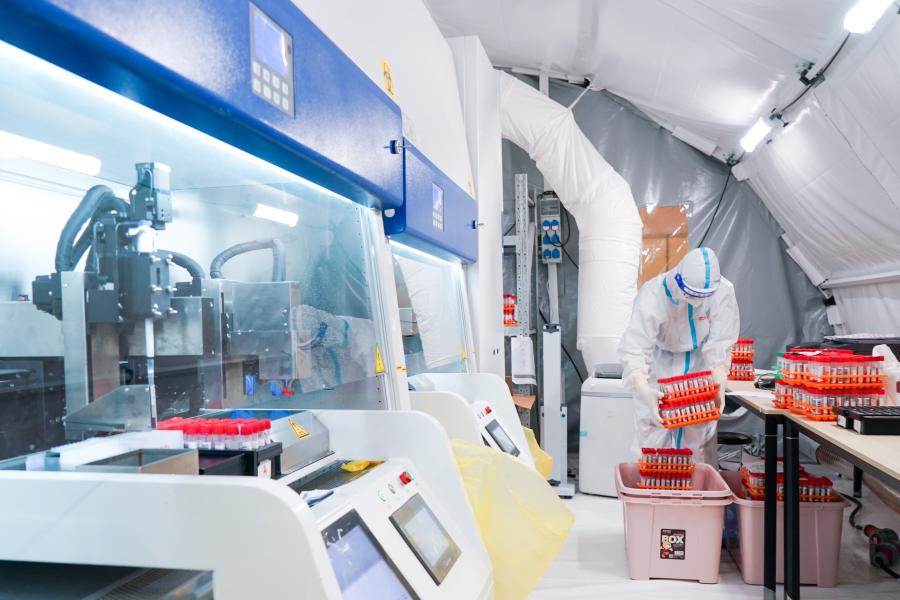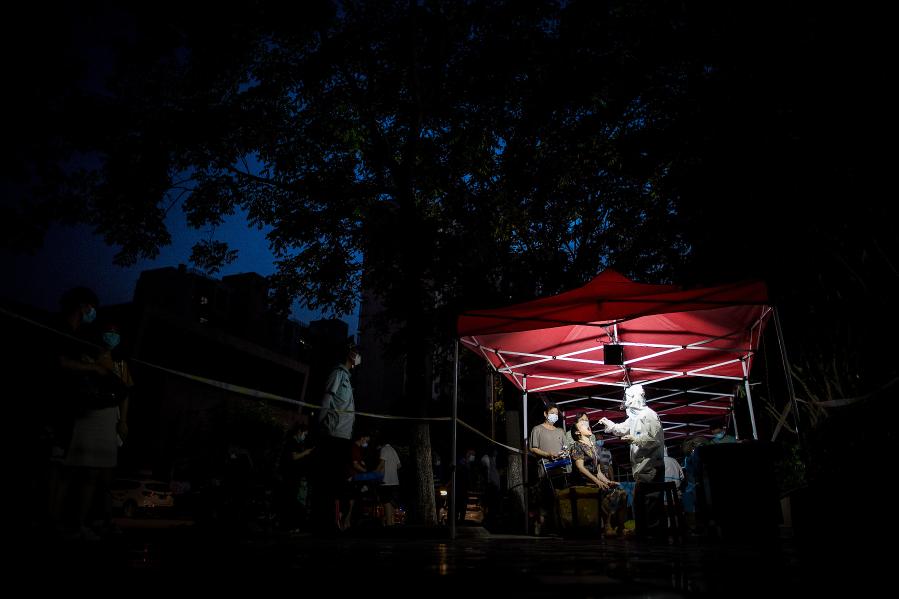Risking no lives, China's anti-virus approach shows nation's priority
-- The daily increase of China's locally confirmed COVID-19 infections fell to single digits on Monday, with only six cases reported following the resurgence from the highly contagious Delta variant.
-- During the resurgence, the daily increase of locally transmitted confirmed cases jumped to 108 on Aug. 9.
-- Since July, strict, scientific, and swift measures have been implemented in affected areas, highlighting the country's principle of putting people's lives first.
BEIJING, Aug. 17 (Xinhua) -- The daily increase of China's locally confirmed COVID-19 infections fell to single digits on Monday, with only six cases reported, showing the efficacy of the country's targeted and intensive control measures following the resurgence from the highly contagious Delta variant.
Three locally confirmed cases were each reported Monday in east China's Jiangsu Province, where the recent Delta outbreak first emerged in mid-July, and the central province of Hubei, hit hard by COVID-19 last year.
 Washington tries everything to buoy up the economy but does little to contain the virus and save lives. (Xinhua/Pan Hongyu)
Washington tries everything to buoy up the economy but does little to contain the virus and save lives. (Xinhua/Pan Hongyu)
During the resurgence, the daily increase of locally transmitted confirmed cases jumped to 108 on Aug. 9. A total of 18 provincial-level regions had reported local infections as of Aug. 12, and no deaths were reported, said figures released by the National Health Commission.
Strict, scientific, and swift measures have been implemented in affected areas since July, highlighting the country's principle of putting people's lives first. With massive nucleic acid testing, accelerated vaccination, closed-loop management, and travel restrictions in place, China has seen an apparent downward trend in new locally transmitted COVID-19 cases.
FRONTLINE WORKERS
Medics, disease control and prevention workers, police officers, community workers, and volunteers countrywide went all out in the frontlines to battle the virus.
Jiangsu mobilized more than 4,000 medical workers and thousands of volunteers and community workers to deter the spread of the virus. Meanwhile, Yangzhou City, the latest hotspot for the new infections in Jiangsu, launched multiple rounds of massive nucleic acid testings.
As of Sunday, Jiangsu reported 802 locally confirmed cases, including 235 cases in Nanjing, the provincial capital, and 552 cases in Yangzhou. According to statistics, patients aged under 14 accounted for 10.1 percent, with the youngest four months old. Elderly patients accounted for 32.7 percent, with the eldest patient aged 91.
 A medical worker is seen at a "Falcon" air-inflated testing lab for nucleic acid testing at Yangzhou International Exhibition Center in Yangzhou, east China's Jiangsu Province, Aug. 14, 2021. (Xinhua/Li Bo)
A medical worker is seen at a "Falcon" air-inflated testing lab for nucleic acid testing at Yangzhou International Exhibition Center in Yangzhou, east China's Jiangsu Province, Aug. 14, 2021. (Xinhua/Li Bo)
Yangzhou reported six and three locally confirmed cases on Sunday and Monday, respectively, according to the provincial health commission.
"The new cases are mostly concentrated in the group under control measures, indicating that the spread of the virus is under control to some extent," said Zhang Jinhong, deputy head of the Jiangsu Provincial Health Commission.
The province mobilized more than 3,000 medical workers to help with massive nucleic acid testings in Yangzhou, with a permanent population of 4.55 million.
"We spared no effort to treat every patient," said Yang Yi, an intensive care expert with Zhongda Hospital of Southeast University in Nanjing. Yang added that some critically ill patients were getting better with the introduction of ventilators or extracorporeal membrane oxygenation (ECMO) machines.
 A medical worker takes a swab sample from a resident for nucleic acid testing at a residential community in Wuhan, central China's Hubei Province, Aug. 3, 2021. (Xinhua/Xiao Yijiu)
A medical worker takes a swab sample from a resident for nucleic acid testing at a residential community in Wuhan, central China's Hubei Province, Aug. 3, 2021. (Xinhua/Xiao Yijiu)
Wuhan, the capital of Hubei, also reported new local infections among several migrant workers. Within five days, over 11.28 million residents in the megacity had been tested thanks to the efforts of over 28,000 medical workers in more than 2,800 sampling sites, the municipal government said.
"We worked in the laboratory around the clock to ensure reliable and timely test results," said Shao Lihua, director of the PCR laboratory of the KingMed Diagnostics in Wuhan. His department tested up to 28,000 nucleic acid samples in a single day.
Having experienced the epidemic outbreak last year, Shao said what impressed him most was that the country regards protecting people and their lives as its top priority.
Wuhan organized 21 medical experts covering respiratory, critical medicine, infection, iconography, and other disciplines, to provide tailored treatment for all COVID-19 patients, said Huang Chaolin, director of Wuhan Jinyintan Hospital.
In Changsha, capital of Hunan Province, community workers provided door-to-door nucleic acid testing and disinfection services in neighborhoods under closed-off management. Volunteers delivered living necessities and medicine for residents every day. On Aug. 13, the city cleared its medium and high-risk areas.
PEOPLE-CENTERED APPROACHES
Zhangjiajie, a popular tourist destination in Hunan Province, recently registered a new cluster of infections. Local authorities provided free accommodation and food for stranded visitors and arranged medical staff to conduct nucleic acid tests for tourists at hotels.
 Tourist Zhang Maodi from Shanghai exercises in his room at a quarantine hotel in Wulingyuan District of Zhangjiajie, central China's Hunan Province, Aug. 8, 2021. (Xinhua/Chen Sihan)
Tourist Zhang Maodi from Shanghai exercises in his room at a quarantine hotel in Wulingyuan District of Zhangjiajie, central China's Hunan Province, Aug. 8, 2021. (Xinhua/Chen Sihan)
A psychological medical team provided mental health consulting to residents, tourists, and medical workers.
The province also organized experts in traditional Chinese medicine (TCM) to develop customized treatment programs for severe cases, moderate cases, mild ones, and asymptomatic carriers, respectively.
Since the outbreak, Yangzhou has established a rapid response mechanism and introduced relief measures for socially disadvantaged groups. The city had given living allowances totaling 3.7 million yuan (about 572,000 U.S. dollars) to 5,013 households as of Aug. 10.
The city also provided daily necessities and living subsidies to people in difficulties, especially persons with disabilities and children.
On Sunday, the first five patients were discharged from Yangzhou No.3 People's Hospital. They were transferred to another hospital for 14 days of recovery observation before returning to their communities.
"I am happy to see patients who are better and discharged from the hospital. It has greatly improved our confidence in the fight against the epidemic," said Shu Yusheng, president of Northern Jiangsu People's Hospital in Yangzhou.
"The nutrition recipe, mental health counseling, and rehabilitation training make us feel relieved. We have confidence in full recovery soon," said an asymptomatic patient who received rehabilitation treatment in Changde City, Hunan. ■
(Written by Zhang Dan, Ma Xiaoran, Zhang Yujie, Zhang Ge, Yue Wenwan, Chen Shengyi. Video Reporters: Cheng Ji'an, Ding Chunyu; Video editor: Peng Ying.)